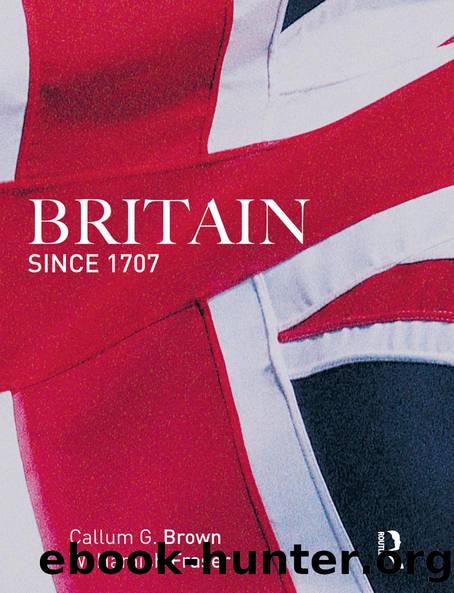Britain Since 1707 by Hamish Fraser Callum G. Brown

Author:Hamish Fraser, Callum G. Brown [Hamish Fraser, Callum G. Brown]
Language: eng
Format: epub
Tags: History, Europe, Great Britain, General
ISBN: 9781317867494
Google: C7EABAAAQBAJ
Publisher: Routledge
Published: 2014-07-10T16:05:31+00:00
Table 20.1 Industrial production in the UK 1853â1938: cotton, coal, pig-iron, steel and steam ships
though smaller yards elsewhere also grew, contributing to the countryâs dominance in both world shipbuilding and world shipping.
These data provide an image of economic growth for the period 1880 to 1913. This image is intensified by looking in Table 20.1 at the decline in production figures for 1913 to 1938. In this longer-term context, Britainâs economic performance before 1914 looks extremely impressive.
There is, however, another image of the economy for this period. This second view is one of relative economic decline and, in certain respects, stagnation. What is the evidence for this? First, there was the start of a slowdown in overall economic growth. Growth in overall output, known as gross domestic product (GDP), showed a drop from 2.1 per cent per annum in 1873â99 to 1.4 per cent in 1907â13. Second, despite British dominance of the world economy for most of this period, there was a decline in its share of world markets. Between 1899 and 1913, the value of British exports grew by 48 per cent, but, as a proportion of all world exports, they declined from 36 per cent to 30 per cent (and continued to fall to 20 per cent by 1929).1 Third, British industry was succeeding well in traditional staple industries, but it was performing much less strongly in newer industries than other countries. It was especially poor in consumer and consumer-related goods â electricity production, electrical products, motor cars, pharmaceuticals and chemicals, as well as cheaper consumer products like pianos and trinkets of various kinds. Production, sales, and exports of these new goods tended to be rising much more steeply in the USA and Germany than in Britain. And fourthly, the dominance and cheapness of home coal was making the British economy difficult to modernise. Coalâs cheapness made it uneconomic for many industrialists to move to electrical power, and this hindered the development of electrical products and electricity-powered production. It also reduced the speed with which Britain moved from coal-fired to diesel-powered ships.
Part of the story here concerns a downturn in economic performance in Britain in the first part of the period. Between 1873 and 1896 there was what was called at the time (and since) the âgreat depressionâ in the British economy. This is especially associated with the performance of British agriculture, and the growing dependence on the importation of foodstuffs â including meat brought under refrigeration for the first time from New Zealand, Australia, South America and the USA. Although British agricultural workers and the British countryside were adversely affected by falling prices for food as imports rose, the bulk of the population, of course, gained greatly from this. Cheap, usually imported, foodstuffs more than made up for stagnating wage rates. Consumption of food, clothing and even luxuries went up. Chains of food shops â with names like Thomas Liptonâs from Glasgow, Coopers in Liverpool, John Williams in Manchester, and John Sainsburyâs in London, as well as Co-operative
Download
This site does not store any files on its server. We only index and link to content provided by other sites. Please contact the content providers to delete copyright contents if any and email us, we'll remove relevant links or contents immediately.
The European History Highway: A Guide to Internet Resources by Dennis A. Trinkle Scott A. Merriman(496)
The Seven Wonders of the Ancient World by Michael Denis Higgins(479)
European Security in a Global Context by Thierry Tardy(471)
European Security without the Soviet Union by Stuart Croft Phil Williams(470)
The Routledge companion to Christian ethics by D. Stephen Long Rebekah L. Miles(459)
Hudud Al-'Alam 'The Regions of the World' - a Persian Geography 372 A.H. (982 AD) by V. V. Minorsky & C. E. Bosworth(399)
Gorbachev And His Generals by William C. Green(391)
Get Real with Storytime by Julie Dietzel-Glair & Marianne Crandall Follis(390)
Tibetan Studies in Comparative Perspective by Chih-yu Shih Yu-Wen Chen(386)
Governance, Growth and Global Leadership by Espen Moe(383)
Hyperculture by Byung-Chul Han(379)
CliffsNotes on Fitzgerald's The Great Gatsby by Kate Maurer(360)
The Oxford History of the World by Fernández-Armesto Felipe;(354)
How Languages Are Learned 5th Edition by Patsy M Lightbown;Nina Spada; & Nina Spada(353)
The Egyptian Economy, 1952-2000 by Khalid Ikram(352)
Oral Poetry and Narratives from Central Arabia: The Poetry of Ad-Dindan : A Bedouin Bard in Southern Najd (Studies in Arabic Literature, Vol 17) (English and Arabic Edition) by P. M. Kupershoek P. Marcel Kurpershoek(345)
The Oxford Handbook of the Incas by Sonia Alconini(333)
Europe Contested by Harold James(320)
The Hutchinson Dictionary of Ancient and Medieval Warfare by Peter Connolly John Gillingham John Lazenby(306)
